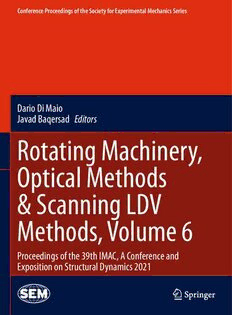
Rotating Machinery, Optical Methods & Scanning LDV Methods, Volume 6: Proceedings of the 39th IMAC, A Conference and Exposition on Structural Dynamics ... Society for Experimental Mechanics Series) PDF
Preview Rotating Machinery, Optical Methods & Scanning LDV Methods, Volume 6: Proceedings of the 39th IMAC, A Conference and Exposition on Structural Dynamics ... Society for Experimental Mechanics Series)
Conference Proceedings of the Society for Experimental Mechanics Series Dario Di Maio Javad Baqersad Editors Rotating Machinery, Optical Methods & Scanning LDV Methods, Volume 6 Proceedings of the 39th IMAC, A Conference and Exposition on Structural Dynamics 2021 Conference Proceedings of the Society for Experimental Mechanics Series SeriesEditor KristinB.Zimmerman,Ph.D. SocietyforExperimentalMechanics,Inc., Bethel,CT,USA TheConferenceProceedingsoftheSocietyforExperimentalMechanicsSeriespresentsearlyfindingsandcasestudiesfrom a wide range of fundamental and applied work across the broad range of fields that comprise Experimental Mechanics. SeriesvolumesfollowtheprincipletracksorfocustopicsfeaturedineachoftheSociety’stwoannualconferences:IMAC, AConferenceandExpositiononStructuralDynamics,andtheSociety’sAnnualConference&Expositionandwilladdress criticalareasofinteresttoresearchersanddesignengineersworkinginallareasofStructuralDynamics,SolidMechanics andMaterialsResearch Moreinformationaboutthisseriesathttp://www.springer.com/series/8922 Dario Di Maio • Javad Baqersad Editors Rotating Machinery, Optical Methods & Scanning LDV Methods, Volume 6 Proceedings of the 39th IMAC, A Conference and Exposition on Structural Dynamics 2021 Editors DarioDiMaio JavadBaqersad MS3 KetteringUniversity UniversityofTwente Flint,MI,USA ENSCHEDE,Overijssel,TheNetherlands ISSN2191-5644 ISSN2191-5652 (electronic) ConferenceProceedingsoftheSocietyforExperimentalMechanicsSeries ISBN978-3-030-76334-3 ISBN978-3-030-76335-0 (eBook) https://doi.org/10.1007/978-3-030-76335-0 ©TheSocietyforExperimentalMechanics,Inc.2022 Thisworkissubjecttocopyright.AllrightsaresolelyandexclusivelylicensedbythePublisher,whetherthewholeorpartofthematerialisconcerned, specificallytherightsoftranslation,reprinting,reuseofillustrations,recitation,broadcasting,reproductiononmicrofilmsorinanyotherphysicalway,and transmissionorinformationstorageandretrieval,electronicadaptation,computersoftware,orbysimilarordissimilarmethodologynowknownorhereafter developed. Theuseofgeneraldescriptivenames,registerednames,trademarks,servicemarks,etc.inthispublicationdoesnotimply,evenintheabsenceofaspecific statement,thatsuchnamesareexemptfromtherelevantprotectivelawsandregulationsandthereforefreeforgeneraluse. Thepublisher,theauthors,andtheeditorsaresafetoassumethattheadviceandinformationinthisbookarebelievedtobetrueandaccurateatthedate ofpublication.Neitherthepublishernortheauthorsortheeditorsgiveawarranty,expressedorimplied,withrespecttothematerialcontainedhereinor foranyerrorsoromissionsthatmayhavebeenmade.Thepublisherremainsneutralwithregardtojurisdictionalclaimsinpublishedmapsandinstitutional affiliations. ThisSpringerimprintispublishedbytheregisteredcompanySpringerNatureSwitzerlandAG Theregisteredcompanyaddressis:Gewerbestrasse11,6330Cham,Switzerland Preface RotatingMachinery,OpticalMethods&ScanningLDVMethodsrepresentsoneoftheninevolumesoftechnicalpaperspre- sentedatthe39thIMAC,AConferenceandExpositiononStructuralDynamics,organizedbytheSocietyforExperimental MechanicsandheldonFebruary8–11,2021.ThefullproceedingsalsoincludevolumesonNonlinearStructures&Systems; DynamicsofCivilStructures;ModelValidationandUncertaintyQuantification;DynamicSubstructures;SpecialTopicsin Structural Dynamics & Experimental Techniques; Sensors and Instrumentation, Aircraft/Aerospace, Energy Harvesting & DynamicEnvironmentsTesting;TopicsinModalAnalysis&ParameterIdentification;andDataScienceinEngineering. Eachcollectionpresentsearlyfindingsfromexperimentalandcomputationalinvestigationsonanimportantareawithin structuraldynamics. Theorganizerswouldliketothanktheauthors,presenters,sessionorganizers,andsessionchairsfortheirparticipationin thistrack. Flint,MI,USA JavadBaqersad Enschede,Overijssel,TheNetherlands D.DiMaio v Contents 1 WaveAR:AReal-TimeSensor-BasedAugmentedRealityImplementationforOperating DeflectionShapes.............................................................................................. 1 DanielHerfertandKaiHenning 2 Full-Field 3D Mode Shape Measurement Using the Multiview Spectral Optical Flow ImagingMethod ............................................................................................... 9 DomenGorjup,JankoSlavicˇ,andMihaBoltežar 3 StereophotogrammetryCameraPoseOptimization....................................................... 13 BryanL.Witt,J.JustinWilbanks,BrianC.Owens,andDanielP.Rohe 4 SimplifiedFiniteElementModelsofPyramidalTrussSandwichPanelswithWeldedJoints forDynamicAnalysisandTheirExperimentalValidation ............................................... 39 KeYuanandWeidongZhu 5 Operational Modal Analysis of Rotating Structures Under Ambient Excitation Using TrackingContinuouslyScanningLaserDopplerVibrometry............................................ 51 L. F.LyuandW. D.Zhu 6 DelaminationDetectioninFiberMetalLaminatesUsingUltrasonicWavefieldImaging............. 59 CaseyGardner,YoungKo,MichaelKoutoumbas,EricFlynn,IanCummings,andPhilCornwell 7 One-Dimensional Convolutional Neural Networks for Real-Time Damage Detection ofRotatingMachinery........................................................................................ 73 Onur Avci, Osama Abdeljaber, Serkan Kiranyaz, Sadok Sassi, Abdelrahman Ibrahim, andMoncefGabbouj 8 APracticalGuidetoMotionMagnification ................................................................ 85 SeanCollierandTylerDare 9 SqueezeFilmDamperExperimentalandNumericalCorrelation:TestSetupDescription andParameterIdentificationofDrySystem ............................................................... 93 JasonCook,JayBasinger,ThomasHazelwood,ClaireLuttrell,BlakeVan Hoy,andAdolfoDelgado 10 Full-FieldModalAnalysisbyUsingDigitalImageCorrelationTechnique............................. 105 DavideMastrodicasa,EmilioDiLorenzo,SimoneManzato,BartPeeters,andPatrickGuillaume 11 ValidatingComplexModelsAccuratelyandWithoutContactUsingScanningLaserDoppler Vibrometry(SLDV) ........................................................................................... 113 JeromeEichenbergerandJoergSauer 12 EffectofDifferentTestSetupConfigurationsontheIdentificationofModalParameters fromDigitalImageCorrelation.............................................................................. 125 L.Marchetti,D.Mastrodicasa,E.Di Lorenzo,S.Manzato,L.Bregant,B.Peeters,andP.Lava 13 WaveImage–OrderODSforRotatingMachineries...................................................... 135 MatthiasUrban,DanielHerfert,andMaikGollnick vii viii Contents 14 Multi-LevelDamageDetectionUsingOctreePartitioningAlgorithm................................... 143 MehrdadS.DizajiandZhuMao 15 Photogrammetry-BasedExperimentalModalAnalysisforPlateStructures........................... 147 J.S.KimandY.F.Xu 16 AnOpticalModeShape-BasedDamageDetectionUsingConvolutionalNeuralNetworks........... 157 CelsoT.doCaboandZhuMao 17 Full-Field3DExperimentalModalAnalysisfromDynamicPointCloudsMeasuredUsing aTime-of-FlightImager ...................................................................................... 163 MoisésSilva,AndreGreen,JohnMorales,PeterMeyerhofer,YongchaoYang,EloiFigueiredo, andDavidMascareñas 18 ApplicationofaU-NetConvolutionalNeuralNetworktoUltrasonicWavefieldMeasurements forDefectCharacterization .................................................................................. 167 JoshuaD.Eckels,IsabelF.Fernandez,KellyHo,NikolaosDervilis,EricaM.Jacobson,andAdamJ. Wachtor 19 ApplicationoftheRASTARMethodtoContinuousScanningLDVMeasurements................... 183 D.Di MaioandS.Bruinsma Chapter 1 WaveAR: A Real-Time Sensor-Based Augmented Reality Implementation for Operating Deflection Shapes DanielHerfertandKaiHenning Abstract We present WaveAR, the first sensor-based augmented reality system for structural dynamic measurements of operating deflection shapes. WaveAR offers a significant simplification of the configuration effort of vibration sensor measurementsbyanautomaticallysensortrackingcoupledbyanefficient3Dscangenerationofthestructure.ARmarkers areusedforsensortrackingwhichareplacedonthesensor.Thisallowsthedeterminationofthesensorposerelativetothe scanned structure. For this purpose the vibration sensors must be covered with AR markers. This allows a universal easy applicationalsoforexistingsensorequipment.For3Dscanningandsensortracking,alow-coststereodepthcameraisused. BecausetheARapplicationshouldbeindependentfromdataacquisitionhardware,wehaveimplementedauniversalHTTP Rest-APIinterfacefordataacquisitionconnection.Throughthis,itisalsosupportedtousewirelesssensors.Basedonthis configuration,areal-timevisualizationintheformofanaugmentedrealityapplicationoftheoperatingdeflectionshapescan beperformedunderrealoperatingconditions.Thisenablestheusertoviewthemeasurementfromdifferentperspectivesby movingthecameraaroundtheobjecttobeexamined. Keywords Augmentedreality · Dataacquisition · Operatingdeflectionshapes · Sensorposetracking · 3Dscanning 1.1 Introduction At the current state of technology, the performance of a vibration analysis for construction, evaluation, or dynamic optimizationofstructuresorbuildingsrequiresalotoftimeandhumanresources.Especiallywhenusingmanysensorsand complex structures from a geometrical point of view, a large amount of time has to be planned for the whole measuring process. The structural dynamic validation of the measurement, especially the evaluation of the mode or operational deflection shapes, is currently performed after the measurements. Thus, errors within the measurement process can only bedetectedafterward. Theuseofapplicationsforreal-timevisualizationintheformofanaugmentedreality(AR)representationisanessential pointofinteractionbetweenthedigitalandanalogworldsintheindustrialenvironmentintheageofIndustry4.0.Currently, these systems are used primarily for maintenance tasks, as digital manuals in service and maintenance, in plant and productionplanning,intrainingandfurthereducation,andinmarketing,aswellasatexhibitions.Inmostcasesthesystems areusedaspurevisualizationandthereisnoconsiderationofothersensors.TheuseofARsystemsincombinationwithother sensorsoffersanevenmorerealisticinteractionbetweentheuserandthedigitalapplication.Thereal-timevisualizationof essentialsensorinformationatthesceneoftheeventandalwaysinrelationtothestructureunderinvestigationaresignificant advantagesofthesesystems. These advantages would also be very useful for the field of structural dynamics within the construction phase of new structures,aswellasintheoptimizationphaseofexistingstructureswhichwouldallowadirectinteractionwiththestructure. Thus the vibration response of the structure could be visualized directly during operation. Again, this procedure would significantlyreducethetimeneededtoperformvibrationanalysesandwouldalsoallowdirectanalysesinrealoperationof thestructure. In the context of this publication, the AR system was applied to the modal analysis of a car rim and a steel plate. In additiontotheresults,thesignificanttimesavingsincarryingoutthemeasurementshouldbeshown. D.Herfert((cid:2))·K.Henning DepartmentofStructuralDynamics/PatternRecognition,SocietyfortheAdvancementofAppliedComputerScience,Berlin,Germany e-mail:[email protected];[email protected] ©TheSocietyforExperimentalMechanics,Inc.2022 1 D.DiMaio,J.Baqersad(eds.),RotatingMachinery,OpticalMethods&ScanningLDVMethods,Volume6,ConferenceProceedings oftheSocietyforExperimentalMechanicsSeries,https://doi.org/10.1007/978-3-030-76335-0_1 2 D.HerfertandK.Henning 1.2 Background Inthefieldofstructuraldynamics,everincreasingdemandsaremadeonarealisticvisualizationofthenaturalandoperational modes of vibration. This visualization is necessary to enable an optimal comparability with simulation results and is necessarytoimplementanevenmorepreciseanalysis.Theimprovedvisualizationpossibilitiesof3Danimations,especially ofcomputergamesandmovies,leadtohigherandhigherdemandsalsoonengineeringsoftware. Currently,allformsofvisualizationasdefinedinthereality-virtualitycontinuum[1]areavailable,fromapurelyvirtual vibration animation to a vibration animation in the real environment (see Fig. 1.1). In contrast to real-time visualization applications, these are only available after the measurement is complete. Therefore, a direct interaction with the structure duringoperationisnotpossiblefortheuser. Toachievetheserealisticrepresentations,threethingsarenecessary: 1. 3Dreconstructionwithhighresolutionandtextureofthestructureunderinvestigation. 2. Highmeasurementresolution,sothatinthebestcase,onemeasurementpointcanbeassignedtoeachpointinthetriangle mesh. 3. Texturesfromtherealenvironmenttoprojecttheresultsofthevibrationanalysisontherealbackground. Currently,ARapplicationsaretechnicallyonlypossiblewithelectromechanicalsensors.Theopticalmethodsforvibration measurementarecurrentlynotapplicableforARapplications.Forhigh-speedcameras,areal-timedatastreamviaEthernet isnotfeasibleduetothelargeamountofdata.Withmultipointvibrometers,visualizationoranalysisofthemeasureddatais alsoonlypossibleafterthemeasurement.Thebiggestdisadvantagesofelectromechanicalsensorsarethesignificantlyhigher configuration effort, the measurement resolution, and the difficult surface measurement in comparison to optical methods. Thus,afundamentalaimofthisworkistominimizethesedisadvantagescomparedtotheopticalsensors. 1.3 TechnicalImplementation The aim of the work was the development of software components to accelerate and simplify the measurement chain for vibration analysis of mechanical structures by means of electromechanical sensors. To achieve this aim, three software componentswerecreatedthatcanbeusedautonomouslyorincombination(seeFig.1.2). Fig.1.1 Overviewofallstructuraldynamicrepresentationforms(reality,augmentedreality,virtualreality,virtuality),createdwiththeWaveImage software(gfaitechGmbH)
